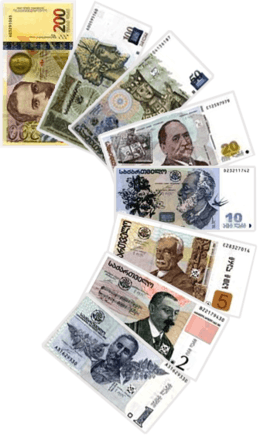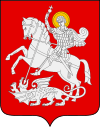Georgian lari
The lari (Georgian: ლარი; ISO 4217: GEL) is the currency of Georgia. It is divided into 100 tetri. The name lari is an old Georgian word denoting a hoard, property, while tetri is an old Georgian monetary term (meaning 'white') used in ancient Colchis from the 6th century BC. Earlier Georgian currencies include the maneti, abazi, and Georgian coupon.
| Georgian lari | |||||
|---|---|---|---|---|---|
| ქართული ლარი | |||||
| |||||
| ISO 4217 | |||||
| Code | GEL | ||||
| Denominations | |||||
| Subunit | |||||
| 1/100 | tetri | ||||
| Plural | The language(s) of this currency do(es) not have a morphological plural distinction. | ||||
| Symbol | ₾ ( | ||||
| Banknotes | |||||
| Freq. used | 5, 10, 20, 50, 100 lari | ||||
| Rarely used | 1, 2, 200 lari | ||||
| Coins | 1, 2, 5, 10, 20, 50 tetri, 1, 2 lari | ||||
| Demographics | |||||
| User(s) | |||||
| Issuance | |||||
| Central bank | National Bank of Georgia | ||||
| Website | www | ||||
| Valuation | |||||
| Inflation | 1.9% (November 2018) | ||||
| Source | National Bank of Georgia | ||||
Kuponi
Georgia replaced the Russian ruble on 5 April 1993, with the Kuponi at par. This currency consisted only of banknotes, had no subdivisions and suffered from hyperinflation. Notes were issued in denominations between 1 and 1 million Kuponi, including the somewhat unusual 3, 3000, 30,000 and 150,000 Kuponi.
Lari
On 2 October 1995,[2] the government of Eduard Shevardnadze replaced the provisional coupon currency with the Lari, at a rate of one million to one. It has remained fairly stable since then.
Lari sign
.jpg)
On 8 July 2014, Giorgi Kadagidze, Governor of the National Bank of Georgia (NBG), introduced the winning proposal for the sign of the national currency to the public and its author. The Georgian lari had its own sign.[3]
The NBG announced the Lari sign competition in December 2013. The temporary commission consisted of representatives of NBG, the Budget and Finance Committee of the Parliament of Georgia, the State Council of Heraldry, the Ministry of Culture and Monument Protection of Georgia and the Ministry of Education and Science of Georgia.[4]
In choosing the winning sign, the commission gave priority to the samples based on the Georgian Mkhedruli character and made a point of the following criteria: conception, design, accordance with Georgian alphabet, existence of elements marking the currency, ease of construction, and observance of requests and recommendations determined by competition rules.[4]
The Lari sign is based on an arched letter ლ (Lasi) of the Georgian script. It is common international practice for a currency sign to consist of a letter, crossed by one or two parallel lines. Two parallel lines crossing the letter Lasi are the basic components of the Lari sign. The so-called “leg” of the letter, represented by a horizontal line, is a necessary attribute of the sign, adding monumental stability to the upper dynamic arc. The form of the letter is transformed in order to simplify its perception and implementation as a Lari sign.[4]
The author of the winning sign is a professional artist-ceramist, Malkhaz Shvelidze.[4]
On 18 July 2014, Giorgi Melashvili, executive director of the National Bank of Georgia, sent a request letter to the Unicode Consortium to register the symbol in the Currency Symbols block of the Unicode Standard as
- ₾
U+20BE GEORGIAN LARI SIGN[5]
On 17 June 2015, the Unicode Consortium released[6] Unicode V8.0, which includes the Lari sign as
- U+20BE ₾ LARI SIGN (HTML
₾)[7]
Coins
Coins are issued in denominations of 1, 2, 5, 10, 20 and 50 tetri, as well as 1 and 2 lari.
| Second Series (2006) | ||||||||
|---|---|---|---|---|---|---|---|---|
| Image | Value | Technical parameters | Description | |||||
| Obverse | Reverse | Diameter | Mass | Composition | Edge | Obverse | Reverse | |
.jpg) |
.jpg) |
50 Tetri | 24 mm | 6.52 g | Stainless Steel | Smooth | The denomination numeral “50”, and the legend “თეთრი” (tetri). | The coat of arms of Georgia, surrounded with a symbolic image of Sun beams, the legends “საქართველო”, and the date of issue “2006” under the coat of arms. |
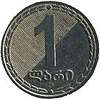 |
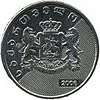 |
1 Lari | 26.2 mm | 7.85 g | Copper-nickel | Reeded with incuse lettering: the country name in Georgian and English (საქართველო and GEORGIA) | Half-milled. Denomination numeral “1” and legend “ლარი” (lari). | Half-milled. The coat of arms of Georgia, the legend “საქართველო” on the upper left side, and the date of issue “2006” on the lower right side. |
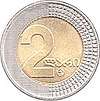 |
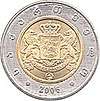 |
2 Lari | 27 mm | 8 g | Bi-Metallic Copper-aluminium-nickel center in Copper-nickel ring | Reeded with incuse lettering: the country name in Georgian and English (საქართველო and GEORGIA) | Denomination numeral “2” and legend “ლარი” (lari). The silver-color milled surface has an original design, representing a central symbolic image of sun rays. | The coat of arms of Georgia, the rim with a circular legend “საქართველო”, and the date of issue “2006”. |
| First series (1993) | ||||||||
|---|---|---|---|---|---|---|---|---|
| Image | Value | Technical parameters | Description | |||||
| Obverse | Reverse | Diameter | Mass | Composition | Edge | Obverse | Reverse | |
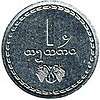 |
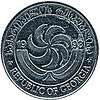 |
1 Tetri | 15 mm | 1.38 g | Stainless Steel | Smooth | The denomination numeral "1" on the upper part of the coin, with the legend “თეთრი” (tetri) and the vine tendril underneath. | The Borjgali (a Georgian symbol of the Sun with seven rotating rays) over the Christian Tree of Life, and the date of mintage, “1993”, with Georgian and English marginal legends on it, “საქართველოს რესპუბლიკა” and “REPUBLIC OF GEORGIA”. |
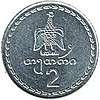 |
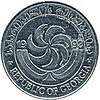 |
2 Tetri | 17.5 mm | 1.9 g | Stainless Steel | Smooth | Peacock with spread wings on the upper part of the coin, with the legend “თეთრი” (tetri) and denomination numeral “2” underneath. | |
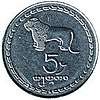 |
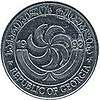 |
5 Tetri | 20 mm | 2.5 g | Stainless Steel | Smooth | Golden statue of a lion from the 3rd millennium B.C. barrow of the Alazani valley, with the denomination numeral “5”, and the legend “თეთრი” (tetri) underneath. | |
 |
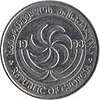 |
10 Tetri | 21.9 mm | 3 g | Stainless Steel | Smooth | Saint Mammes riding the lion, 11th century silver plate gilded with gold from the Gelati Monastery. The denomination numeral “10” on the right hand of the coin, and the legend “თეთრი” (tetri) underneath | |
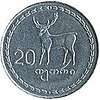 |
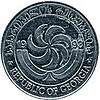 |
20 Tetri | 25 mm | 5 g | Stainless Steel | Smooth | The stag from a painting by the Georgian painter Niko Pirosmanashvili (Pirosmani), with the denomination numeral “20” on the left-hand side, and the legend “თეთრი” (tetri) underneath. | |
.jpg) |
.jpg) |
50 Tetri | 24 mm | 6.52 g | Brass | Smooth | The relief of a Griffin from the eastern façade of 11th century Samtavisi Cathedral, with the denomination numeral “50”, and legend “თეთრი” (tetri) underneath. | |
Banknotes
2016-2019 (current) Series
Between November 2016 and October 2019 the National Bank of Georgia released five banknotes (in denominations of ₾5, ₾10, ₾20, ₾50, and ₾100), comprising a new complete set.[8] The 2016-2019 series lari notes are produced by Polish Security Printing Works (Polska Wytwórnia Papierów Wartościowych).[9]
| Image | Value | Dimensions | Main colour | Description | Date of | ||||||
|---|---|---|---|---|---|---|---|---|---|---|---|
| obverse | reverse | obverse | reverse | printing | issue | ||||||
 |
 |
₾5 (Khuti lari) | 122 × 62 mm | Brown | Portrait of Georgian author Ivane Javakhishvili with the legend “ივანე ჯავახიშვილი 1876-1940", main building of the Ivane Javakhishvili Tbilisi State University | Details from Niko Pirosmani paintings Threshing and Fisherman in a Red Shirt, and the coat of arms of Georgia | 2017 | 1 September 2017 | |||
 |
 |
₾10 (Ati lari) | 127 × 64 mm | Blue | Portrait of Georgian author Akaki Tsereteli with the legend “აკაკი წერეთელი 1840–1915", an excerpt from Tsereteli's poem Spring | Detail from Georgian artist David Kakabadze's painting Imereti - My Mother, and the coat of arms of Georgia | 2019 | 1 October 2019 | |||
 |
 |
₾20 (Otsi lari) | 132 × 66 mm | Magenta | Portrait of Ilia Chavchavadze, with the legend "ილია ჭავჭავაძე 1837 - 1907", the magazines Sakartvelos Moambe and Iveria, founded by him, and his personal belongings | Sculpture of King Vakhtang Gorgasali, founder of Tbilisi, Vakhushti Bagrationi's 18th century map of Tbilisi, a panorama of old Tbilisi and the Narikala fortress, and the coat of arms of Georgia | 2016 | 1 February 2016 | |||
 |
 |
₾50 (Ormotsdaati lari) | 137 × 68 mm | Green | Portrait of Georgian Queen Tamar with the legend “თამარ მეფე XII ს.", 12th-13th century Vardzia cave monastery complex and a bas-relief from the 13th century Pitareti Virgin Mary Monastery | Miniature of a Sagittarius, a 12th century manuscript, and the coat of arms of Georgia | 2016 | 1 February 2016 | |||
 |
 |
₾100 (Asi lari) | 142 × 70 mm | Violet | Portrait of the Georgian poet Shota Rustaveli with the legend "შოთა რუსთაველი XII ს.", an illustration from the epic poem The Knight in the Panther's Skin, a page from its original prints and an ornament from its original manuscript and a 7th century bas-relief of Daniel in the lions' den from the Martvili Cathedral of Assumption of the Virgin Mary | The Zakaria Paliashvili Georgian National Opera Theater, a fragment from the score of the Georgian national anthem and the coat of arms of Georgia | 2016 | 1 November 2016 | |||
| These images are to scale at 0.7 pixel per millimetre. For table standards, see the banknote specification table. | |||||||||||
Earlier Issues
| Image | Value | Dimensions | Main colour | Description | Date of | Remarks | |||||
|---|---|---|---|---|---|---|---|---|---|---|---|
| obverse | reverse | obverse | reverse | printing | issue[10] | withdrawal | |||||
 |
 |
₾1 (Erti lari) | 115 × 61 mm | Green/Grey | Portrait of Georgian artist Niko Pirosmanashvili (Pirosmani) with the legend "Pirosmani 1862-1918". | Panorama of Tbilisi, the capital of Georgia, and an image of a stag from Pirosmani's painting. | 2002 | 5 August 2002 | coins minted since 2006 | ||
 |
 |
₾2 (Ori Lari) | 115 × 61 mm | Green/Orange | Portrait of Georgian composer Zacharia Paliashvili and legend "Zacharia Paliashvili 1871 - 1933" . The left side features the overture notes of his opera Abesalom da Eteri | Building of the Tbilisi Zacharia Paliashvili Opera and Ballet State Theatre with the legend "Tbilisi National Opera and Ballet Theatre 1887". | 2002 | 5 August 2002 | coins minted since 2006 | ||
 |
 |
₾5 (Khuti lari) | 115 × 61 mm | Brown | Portarait of Georgian academic Ivane Javakhishvili, with the legend "Ivane Javakhishvili 1876-1940" | Main building of the Ivane Javakhishvili Tbilisi State University and an open book and a plant ornament underneath | 2002 | 5 August 2002 | |||
 |
 |
₾10 (Ati lari) | 125 × 63 mm | Blue | Portrait of Georgian poet and public figure Akaki Tsereteli, with the legend "Akaki Tsereteli 1840 - 1915", a swallow and blossoming branch | Detail from Georgian artist David Kakabadze's painting Imereti - My Mother and vine tendril | 2002 | 5 August 2002 | |||
 |
 |
₾20 (Otsi lari) | 131 × 65 mm | Navy yellow | Portrait of Georgian public figure Ilia Chavchavadze with the legend "Ilia Chavchavadze 1837 - 1907" the magazines Sakartvelos Moambe and Iveria, founded by him and his personal belongings | Sculpture of King Vakhtang Gorgasali, founder of Tbilisi, a map of Tbilisi from the 18th century by Vakhushti Bagrationi and a panorama of old Tbilisi – a composition of old Narikala | 2002 | 5 August 2002 | |||
 |
 |
₾50 (Ormotsdaati lari) | 135 × 66 mm | Navy green | Portrait of 12th Century Georgian Queen Tamar, image of a griffin on the left hand side of the banknote | "Sagittarius astrological sign" from a Georgian miniature manuscript of the 12th century | 2004 | 9 November 2004 | |||
 |
 |
₾100 (Asi lari) | 140 × 67 mm | Light green | Shota Rustaveli graphic portrait and the legend "Shota Rustaveli XII c". The composition of angels raising the cross is depicted on the left side of the banknote | A composition from the Biblical story "Daniel in the den of lions" from the Martvili monastery relief, and the legend "Martvili VIIc." | 2004 | 9 November 2004 | |||
 |
 |
₾200 (Orasi lari) | 146 × 72 mm | Yellow | Portrait of Kakutsa Cholokashvili. The background of the banknote is enhanced with fragments of relief images of Georgian Cultural Artifacts. | City of Sukhumi and relief fragments of the iconostasis found in the village Tsebelda of Gulripsh district. | 2006 | 15 April 2007 | |||
 |
 |
₾500 (Khutasi lari) | 143 × 66 mm | Green | Portrait of David IV. | Early Georgian inscriptions and a cross | 1995 | never officially released | |||
| These images are to scale at 0.7 pixel per millimetre. For table standards, see the banknote specification table. | |||||||||||
| Current GEL exchange rates | |
|---|---|
| From Google Finance: | AUD CAD CHF EUR GBP HKD JPY USD RUB USD |
| From Yahoo! Finance: | AUD CAD CHF EUR GBP HKD JPY USD RUB USD |
| From XE.com: | AUD CAD CHF EUR GBP HKD JPY USD RUB USD |
| From OANDA: | AUD CAD CHF EUR GBP HKD JPY USD RUB USD |
| From fxtop.com: | AUD CAD CHF EUR GBP HKD JPY USD RUB USD |
| Preceded by: Georgian kupon lari Reason: Replacement of the Soviet and Russian ruble with a transitional currency |
Currency of Georgia April 5, 1993 – October 2, 1995 |
Succeeded by: Georgian lari Reason: Hyperinflation Ratio: 1 Georgian lari = 1,000,000 Georgian kuponi |
| Preceded by: Georgian kuponi lari Reason: Hyperinflation Ratio: 1 Georgian lari = 1,000,000 Georgian kuponi lari |
Currency of Georgia October 2, 1995 – |
Succeeded by: Current |
See also
References
- When the lari sign isn't available to hand, the letter ლ or ISO code is used.
- National Bank of Georgia. "Lari banknotes". Retrieved 30 December 2006.
- "Georgian Lari has its own sign". Retrieved 5 December 2017.
- "National Bank Of Georgia". www.nbg.gov.ge. Retrieved 5 December 2017.
- "Lari proposal" (PDF). Retrieved 5 December 2017.
- "Announcing The Unicode® Standard, Version 8.0". blog.unicode.org. Retrieved 5 December 2017.
- https://www.unicode.org/charts/PDF/U20A0.pdf
- http://ganakhlebulilari.ge/
- http://www.pwpw.pl/index.php?pId=599
- Linzmayer, Owen (2012). "Georgia". The Banknote Book. San Francisco, CA: www.BanknoteNews.com.
External links
| Wikimedia Commons has media related to Money of Georgia. |
- Georgian money, National Bank of Georgia
- Banknotes of Georgia: Georgian Lari Catalog
- Coins of Georgia at CISCoins.net
- The banknotes of Georgia (in English and German)
